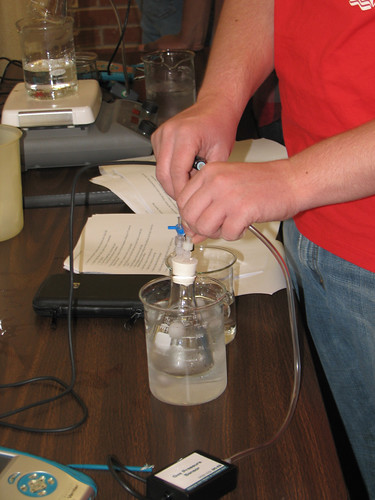Starting a science club
By Mary Bigelow
Posted on 2010-06-07
 I would like to have a science club in our middle school. How should I get started? What types of competitions we can enter? What else should I consider? I have taught Life Science and Physical Science for 15 years.
I would like to have a science club in our middle school. How should I get started? What types of competitions we can enter? What else should I consider? I have taught Life Science and Physical Science for 15 years.
—Liz, Billings, Montana
Working with students in a club setting is a wonderful opportunity to get to know them better and encourage them to develop lifelong interests beyond the classroom. Much of what you can do depends on the size of the club and the logistics of your meetings:
- How long will your meetings be: 30 minutes? A class period? When will you meet? Before or after school? A club period during the day? How often will you meet? Weekly? Bi-weekly? Monthly?
- Is there a limit on the number of students? How will you determine students’ interests and their level of commitment to the club activities?
- Where will you meet? Do you have to stay in your lab or on the school campus during the meeting time? Are field trips a possibility? Will transportation be an issue?
- Is there an activity fund your club can access for materials, entry fees, or transportation?
Participating in formal competitions could provide a focus. These programs have established guidelines and activities and culminate in a project or contest. They do require a high level of commitment, so look at their websites to determine the time and financial issues. You could do an informal trial for a year before committing to an actual competition. See the list at the end for some competitions appropriate for middle schoolers. This is by no means a complete list, but I’ve heard good things about these. Check out the article “Competing to Learn” in NSTA Reports, which describes how some teachers are using competitions to help motivate students and has some suggestions on how to get started with competitions.
Another possibility is involving your club in “Citizen Science” projects. In these regional and nation-wide projects, participants record observations in their own communities and upload data to a project database. Students get to see “their” data used as part of a larger project and are encouraged to pose their own research questions. The Cornell Laboratory of Ornithology has several ongoing projects, including BirdSleuth, which I have worked on. The article Using Citizen Scientists to Measure the Effects of Ozone Damage on Native Wildflowers in the April 2010 issue of Science Scope describes an air quality monitoring project. And in Project BudBurst participants chart their observations of plant growth. These are just a few examples of this type of authentic science investigation.
Here are some suggestions for some “home-grown” activities:
- Ask students about their interests (and be prepared for shoulder shrugs or “we want to blow things up”). But you might be surprised at the topics they suggest, such as ecology, technology, genetics, or robotics. You could choose a different theme each year.
- Have students expand science to other parts of the school. Set up and maintain aquariums or plants in the office, library, or other public areas. Create and maintain flower gardens, vegetable gardens, or water gardens.
- Spearhead a school recycling project, especially for paper or cafeteria waste (see the article “Trash Pie” in March 2010 Science & Children).
- Collaborate with an elementary school. Your club could conduct demos for younger students or assist them with science projects or family night activities (if scheduling permits). Create videos in which your students explain or demonstrate concepts for the younger ones. I observed a project in which older students created “kits” out of small boxes with items such as magnets, hand lenses, small collections of shells, forest floor “litter,” pictures of animals, flash cards, leaves. The students made illustrated field guides or activities to go along with the kits. The elementary teachers used them as take-home activities.
- Set up and monitor a weather station. The students’ report could be part of the daily announcements. Some local television stations even provide the equipment and share student data on the nightly news.
- Conduct build-it events such as egg drop containers, boat floating, kites, paper airplanes, or simple robotic kits. The Internet has suggestions for many of these. Activities involving global positioning satellites and geo-caches are becoming popular, too.
- If field trips are a possibility, visit local water treatment plants, museums, university research centers, or health centers to see the labs, interview scientists/researchers, and learn about careers. Volunteer at parks or nature centers.
However you develop your club, keep it low-key and enjoy yourself. I still reminisce with former students about tracking animals in the snow, determining the water quality at the local reservoir, and testing paper airplane designs.
Competitions
Science Olympiad
Odyssey of the Mind
JETS – Junior Engineering Technical Society
U.S. Department of Energy Science Quiz Bowl
Toshiba/NSTA Exploravision
National Engineers Week Future City Competition
Envirothon (for high school, but you may get some ideas)
Junior Solar Sprint Car Competitions
First Lego League
Photo: http://www.flickr.com/photos/lowercolumbiacollege/4438634434/
Disclaimer: The views expressed in this blog post are those of the author(s) and do not necessarily reflect the official position of the National Science Teaching Association (NSTA).


